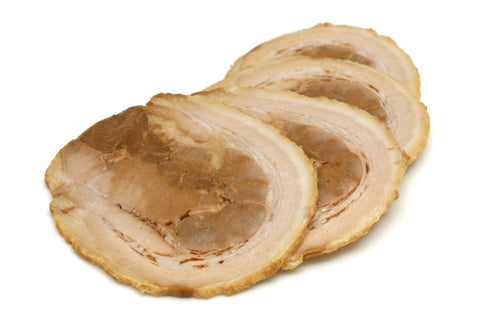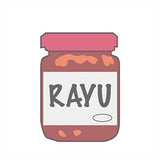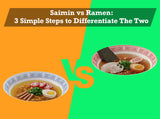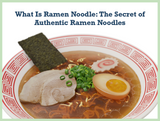
Ramen noodles are made of flour, kansui, and water.
How about ramen soup, toppings or instant noodles?
Keep reading and your will find out...
1. What about instant noodles?
2. What are ramen noodles made of? (in detail)
3. What is ramen soup made of?
4. What are ramen toppings made of?
5. What about ramen seasonings?
6. What about side dishes?
7. What are basic ramen types?
8. Is ramen healthy?
9. Are ramen noodles made of rice?
10. Are ramen noodles made of plastic or wax?
11. What is ramen powder made of?
1. What about instant noodles?

Instant noodles are made out of the same materials as raw ramen noodles.
A lot of people think ramen and instant ramen are very different, but in reality, they’re not really that different!
The noodles in both consist of wheat flour, kansui and water.
Kansui adds some flavour into the noodles and this flavour goes well with the ramen soup.
Here is the process of making ramen or instant noodles
1. Mix kansui and flour together.2. Make the dough flat.
3. Cut into thin noodles.
4. Divide into one-meal portions.
-------Additional process for instant ramen-------
5. Steam the noodles.
6. Dry the noodles.
7. Cool down the noodles.
8. Pack the noodles into cups or bags.
So this additional process turns raw ramen noodles into instant noodles.

2. What are ramen noodles made of? (in detail)
In the beginning, I said ramen noodles are made out of flour, kansui, and water. I will explain each ingredient in detail.
i. Flour

Do you know what kind of flour is used for making ramen noodles?
Keep reading and you will find out...
Do you know there are many different kinds of flour?
There is cake flour, all-purpose flour, and bread flour.
1.The difference between these different types of flour is the amount of protein
Cake flour contains the least amount of proteins.

It contains between 7 to 9 percent of protein.
It is made of soft wheat, which makes this flour smooth and fine.
Since this gives you a soft texture, you can make sponge cake and cookies out of this flour.
Cake flour is also called weak flour.
Bread flour contains the most amount of proteins.

It contains between 13 to 15 percent of protein.
And it is suitable for making bread and pizza dough.
Bread flour is also called strong flour.
All-purpose flour has a protein content between cake flour and bread flour.

It contains 10 to 12 percent of protein.
You can make pancakes, croissants, pie dough, and udon.
It is the most-commonly used flour in North America.
Flour that is used for ramen noodles contains the amount of protein between all-purpose flour and bread flour.

It contains 11 to 13 percent of protein.
At some ramen restaurants, chefs mix cake flour and bread flour in order to make ramen noodles.
If you want to make flour that way...
The ratio of 2 kinds of different flour should be 1 cake flour and 3 bread flour.
Example:
If you want to make 400 grams of flour for ramen noodles...
Cake flour should be 100 grams and bread flour should be 300 grams.
It is hard to make ramen noodles using only bread flour since it doesn’t absorb water easily,
So you mix cake flour with it since it absorbs water well.
Caution:
If you mix too much cake flour, you will lose the good chewy texture of ramen.
But if you mix too little cake flour, it will be difficult to mix the dough with water so it doesn’t come together.

2. Ash content decides the color of noodles

There is one more thing you should know about flour.
It is the ash content of flour.
The ash content is the mineral content in the flour.
Usually percentage of ash content of flour for ramen is 0.3 to 0.45%
If ash content is low in the flour, your ramen noodles become white,
And if there is more ash in the flour your ramen noodles will have a distinct color.
Do you know why there is this difference?
If you only use the core part of wheat grain for flour, you will get less ash and white flour.
But if you also use the part that is close to the surface of the wheat grain, you will get more ash and the color gets darker.

It also depends on kinds of wheat too.
The low ash flour has pure taste and high ash flour has more nutrition.
ii. Kansui
Kansui is an alkaline solution (usually sodium carbonate or potassium carbonate).
Kansui makes noodles...
- Yellow,
- Chewy, and
- Gives it its distinct ramen noodle flavor.
So how did people know to add kansui to wheat flour and water to make ramen?
Long ago in Inner Mongolia, some people made noodles out of flour and water from a salty lake.

The salt water had sodium chloride, and the completed noodles were chewy and had a nice flavour.
Since then, this type of chewy noodles have gotten very popular and spread all over China.
The lake is called Kanko (鹹湖) and the water is called kansui (鹹水).
There are two kinds of kansui that are sold in Japan.
Powder type and liquid type.
You make liquid kansui by mixing powdered kansui with water.
The amount of powder kansui you use is usually around 0.5 to 2 percent of the weight of the wheat flour.
For homecooks, baking soda is used instead of kansui most of the time.

iii. Water
Amount of water that you mix with flour is very important.
Water addition rate is calculated this way…
Example:
You use 1000 grams of flour and 300 grams of water to make ramen noodles.
That means water addition of the noodles is 30 percent.
Regular ramen noodles are made of 30 to 35 percent of water addition.
Low water addition rate noodles are under 30 percent,
And high water addition rate noodles are over 35 percent.
Characteristics of noodles with very little addition of water: (Under 30%)
- Since they don’t hold a lot of water, they can absorb more soup.
- Goes well with soup.
- Gets soggy easily.
- Easier to preserve since it contains less water.
- Texture is more dense.
You can taste the flavour of the flour more than noodles with more water added.
If it contains less than 20% of water, the texture of the noodle will become too stiff and rough.
Since these noodles originally do not contain a lot of water content, they will absorb soup very well.
But, that means they will get soggy easily.
The best way to enjoy this type of noodles is through Hakata ramen's kaedama (refill) system.
New noodles are added into your soup each time you’ve finished eating.
Instead of sitting in your broth and becoming soggy, you get a fresh new refill each time.
Characteristics of noodles with lots of water added to it: (Over 35%)
- It does not absorb soup.
- It is not easy for soup to cover this kind of noodles.
- They go with thick, creamy, and rich soup.
- The amount of toppings for this type of noodles tend to be more voluminous than its counterpart. A lot of chashu and vegetables with thick and creamy soup is ideal for high water-addition noodles like Jiro-kei ramen.
- The noodles do not get soggy easily.
- Noodles with lots of water added to it during the production stage are much softer since water content is much higher.
- They are chewy.
- These noodles are more difficult to preserve since it contains a lot of water.

What about the proportion of kansui?
Water addition rate is calculated by the total amount of water that you add to flour.
So you include the amount of kansui when you talk about the water addition rate of ramen noodles.
iv. Additional Ingredients
Some ramen chefs use some additional ingredients in order to make their noodles unique.
These are some examples of additional ingredients…
1. Egg white

Egg white makes ramen noodles chewier and it also prevents ramen noodles getting soggy.
2. Egg yolk
Egg yolk makes ramen noodles bouncier. It also adds yellow color to the noodles.
3. Sake (Japanese wine)

Sake flavor covers up the smell of kansui. Some people don’t like the smell of kansui if it is too much.
3. What is ramen soup made of?
Ramen soup consists of 3 components:
Broth (dashi) + Sauce (tare) + Seasoning Oil (koumiyu)

Let's take a look at what each component is.
What is “dashi”?
A lot of ramen restaurants start preparing the broth at least two days before it is used.
In Japan, some chefs will close down their store for the day if they aren't 100% satisfied with the flavor of their broth.
This is because the soup is a very important element of the dish and will alter the overall taste of the ramen. (They are so serious about their art, right?)
Broth is made up of water and a combination of pork bone, beef bone, chicken, bonito, konbu (kelp), mushroom, or scallops.
You boil the ingredients for many hours to get the flavors to transfer into the soup. The ingredients itself, however, are not used and are thrown away in the end.
The broth is the building block of ramen soup stock as it has the most important element of "umami."
Here are some ingredients for ramen broth…
Pork bone

Chicken

Bonito

Konbu (kelp)

Niboshi

Mushroom

Scallop

What is "tare"?

The purpose of tare is to give the soup its salty taste. There are many types of tare - soy sauce tare, salt tare, and miso tare.
Soy sauce tare is in a liquid form, miso tare is a paste, and salt tare is a powder.
Chefs choose tare based on the broth they are making.
For example, if the broth is a light one, you pick salt tare to match the plain and simple style of the broth.
If the broth is thick, you use miso tare in order to create a thick and creamy soup base.
What is "komiyu"?

Seasoning oil gives ramen its flavor.
In addition, using koumiyu keeps the ramen hot because it covers the surface of the soup, trapping the heat inside.
Some types of koumiyu include chicken oil, pork fatback, and bonito.
4. What are ramen toppings made of?

Ramen toppings are excellent supporting roles.
If there are not any topping on ramen noodles, it will look so different.
Ramen toppings add esthetics, richness, and a great overall visual impression onto your ramen.
Chashu

Chashu is a thinly-sliced piece of braised pork.
The origin of the word “chashu" is actually Chinese and it literally means, fork-roasted (pork).
However, the Japanese meaning of the word refers to braised pork in general.
The 3 most popular kinds of marinade for chashu are soy sauce, miso, and salt.
The location of the cut of pork plays a vital role in the taste of the chashu.
Butabara: Pork belly chashu is the best for people who enjoy the fatty taste of pork.

Rosu: Pork loin chashu is the lean part of the pork, which is a great option for the health-conscious or for people who don’t like the oily taste of fatty meats.

Katarosu: A good combination of both the fatty part of the chashu and red meat is the pork shoulder.

For people who can’t have pork due to health reasons or religious reasons,
there are some great alternatives available in Japan: beef chashu, chicken chashu, and duck chashu
Usually, for beef chashu, the bottom round is used, while for chicken and duck chashu, the breast is most often used.
Ajitama
Debatably, one of the top 2 most popular ramen toppings of all time, is the marinated ramen egg.
The ramen egg is famous and well-loved for its firm and seasoned egg whites, coupled with a soft and succulent egg yolk.
There are many variations of ajitama available to suit different preferences.
Depending on the restaurant, ajitama can be hard-boiled, half-boiled, made with a runny consistency, marinated in soy sauce or vinegar.
Menma
Menma is fermented bamboo shoots. The type of bamboo used to make menma is called machiku (麻竹).
This type of bamboo grows in Taiwan and Southern China. Historically, menma was called shinachiku.
“Shina” is an old name for China which the Taiwanese government disliked.
Hence, the new name “menma” was created which is formed by the two words raMEN and MAchiku.
Green onion
There are two types of green onions as ramen toppings.
Shiraganegi
Literally meaning “white-haired” green onion, the shiranegi is the shredded white part of the green onion.
How it is shredded affects the flavor, so it’s important that the shiranegi is shredded at a right angle and vertically.
Aonegi
Aonegi is chopped green onion. Aonegi ramen is a ramen which has a lot of chopped green onion covering the top of the noodles.
Nori
Japanese sun-dried seaweed is an excellent supporting character of ramen.
Nori was originally a soba topping, however, many soba chefs turned into ramen chefs in Tokyo and thus this topping also migrated over.
Narutomaki
Narutomaki is a fish cake. It is made from a white fish paste.
These fish are used for narutomaki.
Alaska Pollock

Silver White Croaker

Splendid Alfonsino

Southern Blue Whiting

Sesame Seeds
Sesame is a common topping for shio ramen.
Grinding sesame seeds elevate the aroma exponentially.
Kikurage

Cloud ear fungus is especially popular in the southern parts of Japan.
The chewy kikurage adds a different layer of texture to the thin and soft southern-area noodles.
Kikurage doesn’t have a distinct flavour or taste, but it helps decompose fats and oils making thick tonkotsu ramen more mild and easier for digestion.
5. What about ramen seasonings?
Have you wondered about the different bottles of spices and sauces sitting on the table or counter of ramen restaurants?
I will be introducing these different spices so that you can customize the taste of your ramen next time you visit a ramen restaurant.
Black pepper

Pepper adds a bit of a spicy kick to your ramen. It can be an accent to the ramen when used in moderation. When you feel the taste of the soup is a little too simple, give it a try!
Rayu (Chili Oil)

It is a type of hot spicy oil that goes well with miso ramen and tantan-men.
Rayu is frequently used as a condiment for gyoza (Japanese dumplings), but some people use rayu to make their ramen spicy.
Rayu is a well-known condiment of Sichuan cuisine in China. Some famous Sichuan dishes that use rayu are mapo tofu and tantan noodles. You can buy small bottles of rayu at most Asian markets.
However, did you know you can make rayu at home by yourself? It is not difficult to make it from scratch!
By making your own, you can adjust the spiciness to your liking and even make different kinds of rayu by choosing different ingredients.
There are two kinds of rayu.
One is simply flavored oil without any other additions. The other type has some ingredients like peppers, spices, peanuts, leaks, garlic chips, and fried onions.
Vinegar

Used in moderation, vinegar can bring some fresh flavor to your ramen.
Shichimi

7-flavored spices that go well with miso ramen.
Although, we love ramen on its own, adding some condiments to it can significantly enhance and change its overall flavour!
6. What about side dishes?
Do you usually get a couple of side dishes with your ramen when you’re at a restaurant?
I will be introducing some popular side dishes that often accompany ramen noodles.
They will for sure increase your overall satisfaction of your entire meal!
Yaki Gyoza (Fried Dumplings)

Yaki gyoza has…
A savory and roasted aroma.
The bottom of the fried dumplings have a brown and crispy skin.
The side and top have a nice and soft skin.
When you bite into it, juices from the meat and vegetables ooze out.
Once you imagine this, you will really want to have some yaki gyoza.
Yaki gyoza stuffing is made of minced pork, cabbage or nappa, and leeks.
The skin is made of flour, salt, and water.
Chahan (fried rice)

It is a very simple dish made out of rice, eggs and green onions.
However, it is so good that your spoon cannot stop bringing this into your mouth.
Nice aroma of fried eggs and green onions,
Golden color of rice,
The texture of rice that is not too sticky, smooth, or dry.
A good bowl of chahan depends on the skill of the chefs.
How they pan fry and season the dish changes everything.
Chahan is made of rice, sesame oil, green onions, eggs, and diced pork chashu.
Chashu don

Chashu don consists of tender savoury chashu on a hot bowl of rice, covered in sauce that is specifically made for this dish.
The sauce is salty and sweet.
Scorched chashu brings you a really savory aroma.
Chashu don is made of chashu, rice, sauce, and green onions.
Karaage

The outside of the karaage is crispy, while the inside is really juicy.
It is really good to eat when you eat it while it is hot.
The thin coating of karaage makes a crunchy sound as you bite into it.
Karaage is made of chicken, flour, starch, sake, soy sauce, and some seasoning.
Rice/han rice

Some people eat rice with ramen.
Yes, you heard right.
Carb x carb!
Especially, at Ie-kei ramen shop,
People eat white rice with nori(seaweed) that is soaked in the ramen soup.
It is the standard way to eat ramen there.
Han rice means a half bowl of rice.
When you want to eat some extra rice but you are not confident about finishing a whole bowl of rice, you should order han rice.
7. What are basic ramen types?
The soup base is essentially the soul of the dish as it gives the noodles its distinct flavor.
These 4 names of ramen below come from the name of its soup.
Shoyu (soy sauce)

Miso (fermented soybean paste)

Tonkotsu (simmered pork bone)

Shio (salt)

Do you want to know more about these different ramen types?
I have an article that explains in detail.
8. Is ramen healthy?

You might think ramen is considered high in calories and its flavourful broth is also packed with sodium. Right?
There are many good ramen shops around recently, so I understand why you want to know about the calories.
500 to 600 calories.
This is one full bowl of ramen with noodles, toppings and soup.
Keep in mind, the suggested daily intake of calories should be around 2000 to 2500 calories (depending on gender, age, metabolism, and many other factors).
So, after knowing this information, do you still think ramen has a lot of calories?
I don't think it is!
What about other nutritions?
In terms of protein, carbohydrates, and fat,
Ramen has enough of each.
Not too much or too little.
So, the three major nutrients are fine.
However,

Ramen contains very little vitamins and fibers.
Because ramen doesn't have a lot of vegetables.
Ramen lacks some minerals such as iron and calcium.
And the biggest problem of ramen is salt.
You shouldn't have over 2.5 grams of salt per meal.
But if you drink the whole bowl of soup with your ramen, you take in about 10 grams of salt!
That is why you shouldn't drink the whole bowl of ramen soup.
If you stop drinking all the soup, there should be no problem with eating ramen.
Here are some solutions to eat healthier ramen…
9. Are ramen noodles made of rice?
No, ramen noodles are normally made from wheat flour.
Noodle dishes that use rice are…
Pho, chow fun, and vermicelli.

10. Are ramen noodles made of plastic or wax?
No way!
As I said, ramen noodles are made out of flour, kansui, and water.
11. What is ramen powder made of?
Here are the ingredients of the soup packet of instant noodles...
Basic ingredients:
Salt, soy sauce, miso, sauce, sugar, vinegar, and oil

Natural extract:
Meat, seafood, konbu, and vegetables

Powder:
Meat, seafood, vegetables, fruits, mushrooms, and seaweed

Seasoning:
Black pepper, bayleaf, garlic, hot pepper, other spices

Here are the processes of making the soup packets...
1. Dry all the ingredients2. Crush them into powder.
3. Mix the powder in the factory, so that temperature and humidity are all controlled in the ideal condition.
4. Put it in a small package and seal it.
About the Author

Kei is a self-proclaimed ramen lover, blog writer and founder of "Apex S.K. Japanese tableware".
"I am from Ibaraki, Japan.
Ramen is great! It can bring you a sense of happiness and satisfaction that no other food can. I have been eating ramen for 30 years.
If there is no ramen, my life would be miserable.
Ten years ago, I worked as an office worker. The job was really stressful - excessive working hours, low wages, unpaid overtime work, and constantly being yelled at by my boss.
I was new and alone, no girlfriend, no friends, and felt very lonely.
My only oasis was the ramen shop near the office. For me, the ramen chef there was literally an angel. I saw a halo on his head. (No joke)
Tonkotsu shoyu ramen was my all-time favorite. He made ramen with broth chock-full of umami flavor, nice chewy handmade noodles, and tender chashu.
My greatest dream is connect people with ramen through my blog. I want to share a lot of interesting and funny stories and ramen trivia with you.
Knowing more about ramen can help you appreciate your ramen and make it taste extra delicious."
11 Crucial Differences Everyone Should Know: Ramen vs. Pasta













Leave a comment